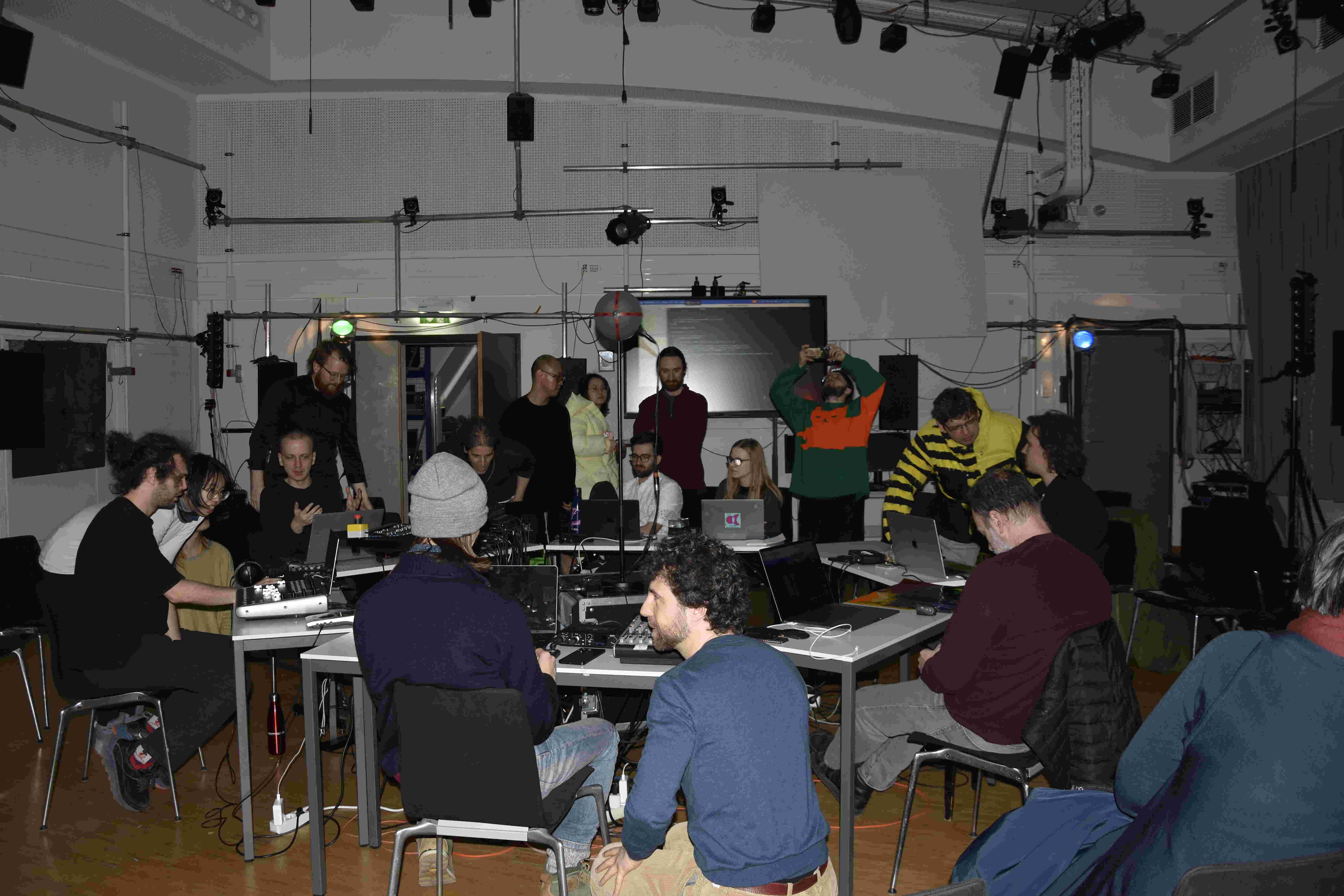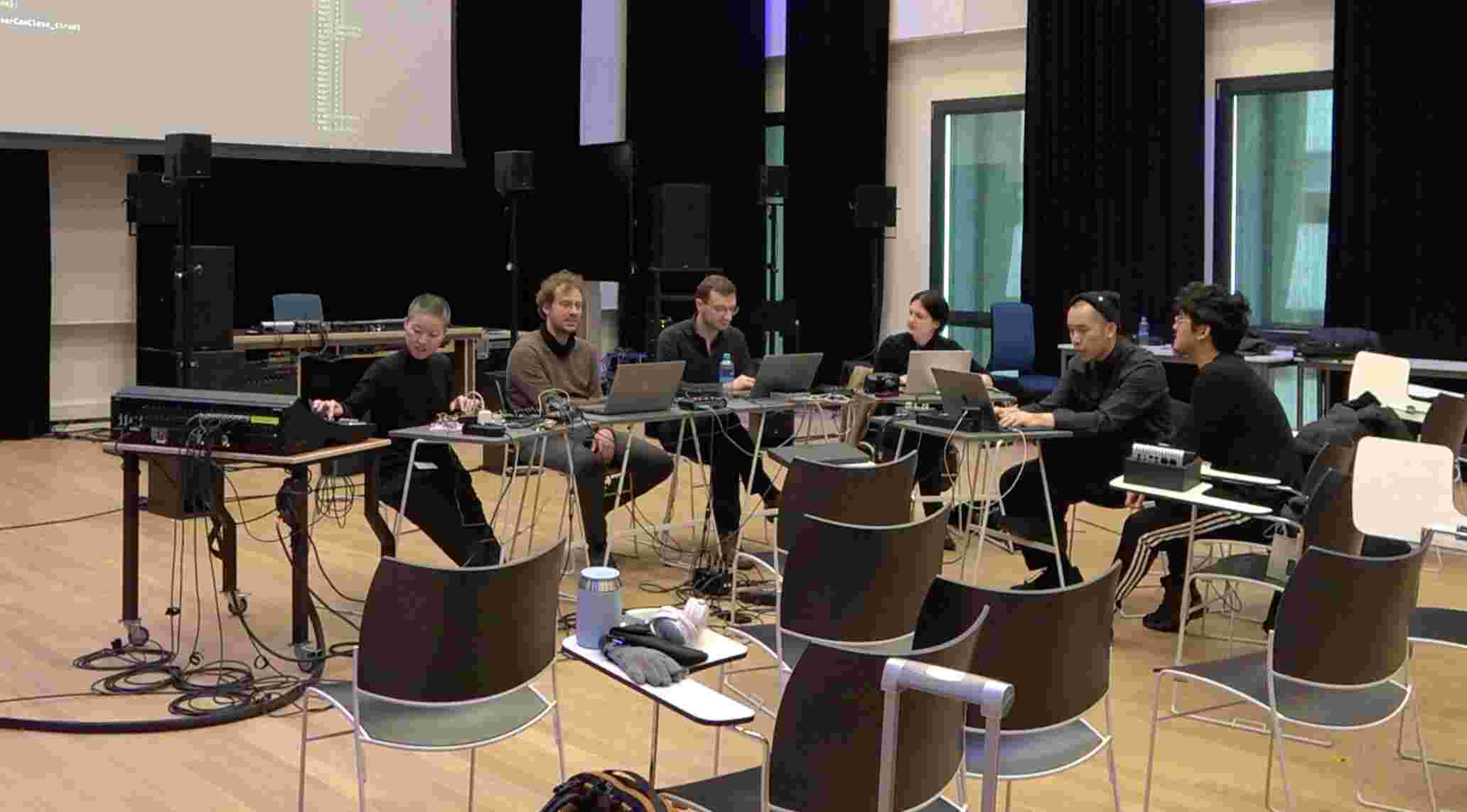Speculative Sound Synthesis
Navigation
Speculative Sound Synthesis
Artistic Research Project
Speculative Sound Synthesis is an artistic research project that deals with the relationship between technology and artistic thinking in computer music. In doing so, it attempts to productively destabilize this relationship by artistically questioning the standards of digital sound synthesis.
The idea of speculation is central to this project, both methodogically as well as aesthetically. Speculation concerns the how, what, and the why of this project, its methods and its objectives. For the team, speculation does not refer to unfounded conjecture or purely theoretical thought removed from concrete practice or experience. On the contrary, speculation can be understood as situated oscillation between experience and imagination that is characteristic of processes that bring forth new forms of knowledge. The project is seen as an attempt to release aesthetic potentials of sound synthesis for artistic practice that would otherwise remain unknown, concealed by standard technological gestures. In this sense, speculation is capable of overcoming inductive or deductive processes and able to dynamize the interrelation of technology and aesthetics.
Speculative Sound Synthesis has started in November 2022 and will end in October 2025. The project is funded by the Austrian Science Fund (FWF) within the Programme for Arts-based Research (PEEK) – PEEK AR 713-G. It is hosted by the Institute of Electronic Music and Acoustics (IEM) at the University of Music and Performing Arts Graz.
The project team consists of David Pirrò and Leonie Strecker. From November 2022 to October 2024, Luc Döbereiner and Ji Youn Kang were part of the project team. Luc Döbereiner was also a co-author of the initial project proposal.
Speculative Sound Synthesis: Synchronisation
Live-Electronics
Luc Döbereiner, Ji Youn Kang, David Pirrò, Leonie Strecker
Speculative Sound Synthesis: Synchronization is a live electronic perfor- mance by four interlinked players exploring ways of coupling sound synthesis systems, algorithmically, performatively, and sonically. The performance is part of the artistic research project Speculative Sound Synthesis hosted at the Institute of Electronic Music and Acous- tic in Graz. The project challenges established patterns of interaction between technology and artistic practice. Standardized processes in computer music are probed, destabilized and reshaped through speculative re-questioning, thus allowing new aesthetic potentials for experimental musical practice to emerge. Rather than focusing on making the instruments produce specific results, the performers aim to make their instruments’ material qualities, assumptions, er- rors, and even failures sensible and experienceable. By putting their instruments and their respective developers in interaction with each other, creating a feedback loop of sorts, the performance explores questions of interplay, materiality of digital and analog sound syn- thesis, interaction with algorithms and machine learning, employing combinations of nonlinear oscillators and analog circuits based on fundamental digital components. The instruments flow into each other, opening up new sonic and musical possibilities through their coupling, thus creating a laboratory where they can experiment, manipulate, observe and speculate on different aspects of the artistic practice of sound synthesis they consider crucial.
Speculative Sound Synthesis Workshop - Impuls 2025
Workshop
David Pirrò, Martin Rumori, and Leonie Strecker
23 - 28 February 2025

with participants of the impuls Academy 2025
Benedikt Alphart | Ted Apel | Francesco Dal Rì | Emanuele Grossi | Georgios Marentakis | Mike McCormick | Nicolas Speda | Justyna Tobera | Lars Fabian Tuchel composition, electronics
The Speculative Sound Synthesis workshop, set up at the impuls Academy 2025, is addressing sound artists, computer music composers and performers who are committed to critical, speculative approaches at the intersection of art and technology, and who are engaged in practices that question, challenge, criticize, deconstruct, recompose, reformulate, shift, dislocate, endanger or reject established standards of sound synthesis and (music) technology. The workshop is part of the artistic research project “Speculative Sound Synthesis”. The aim of the project is to rethink and recompose the relationship between technology and artistic practice in an attempt to unleash aesthetic potentials of sound synthesis that would otherwise remain unknown or hidden within the technological apparatus. In this aesthetic destabilization of analog and digital sound technologies, speculation is the primary method.
During the workshop, each participant developed their own speculative instrument. As a further step, different approaches towards opening up the instruments for receiving and sending sound and data from and to the other instruments were probed, to ultimately create an interconnected, shared agency when playing the instruments together.
Benedikt Alphart ’s instrument is based around a simulacrum-type “physical model” of a singing dune. Singing Dunes are a rare geophonic phenomenon, in which giant heaps of sand produce booming bass drones reaching up to 120dB in volume. The model allows him to mimic its behavior and push parameters beyond their natural range, using his custom built “Mozzarella”-controller.
Ted Apel ’s algorithm uses a spectral representation of sound to manipulate the phase spectrum of sound for unique time manipulations of other performers’ sounds. The amplitude envelope of the resultant sound is controlled by OSC messages from other instruments.
Francesco Dal Rì ’s instrument is centered around three types of feedback: acoustic, signal, and data. The main software component consists of two identical pipelines, each containing a digital multitimbral synthesizer and a neural network, trained to estimate parameters for the synthesizers to emulate input sounds. Using a hardware mixer as main control interface, the behavior of the system is influenced via multiple feedbacks approaches, achieving both stable and chaotic states.
Emanuele Grossi ’s instrument consists of a granulator with per-grain spatialization and stretched parameter possibilities meant for working with large prerecorded field recordings, in this case adapted to record material and use parameters coming from the other musicians’ instruments.
The NSFW (‘Nuther SuperCollider FrameWork’) is a software developed for highly dynamic and expressive control of digital synthesis and processing algorithms in performance. During the Speculative Sound Synthesis workshop Mike McCormick has developed a new module for the system – the NSStripRegressor – which allows him to control many modules at once through a simple interface by using a neural network to perform regression on higher dimensional parameter data.
The instrument of Georgios Marentakis couples live-camera input from a mobile phone to sound synthesized and played or streamed in real-time by the device. This is done based on a series of user-adjustable mappings that shape the timbre and the dynamics of the generated sound. The intention is to explore serendipitous sonic outcomes and emphasize them through gestural performance.
Nicholas Speda receives sound from another participants’ speculative synth and live-codes complex and chaotic effects for it to pass through. Whenever he evaluates code to make adjustments or additions to these effects, the input source switches to a new (random) participants’ synth, making it impossible to predict the outcoming sound beforehand, thus turning every modification of the code into a speculative endeavor. In addition to this, data from typing out his code (e.g. statistic of used keys) is sent out to other participants to further influence their speculative synths (e.g. use as envelopes).
Justyna Tobera ’s instrument is a sensor that reads hand gestures and processes sound, distributing it across a multichannel system. It allows for real-time interaction, where subtle movements influence the spatialization of sound. At the same time, it generates and transforms visualizations based on movement, creating a dynamic audiovisual experience.
By combining techniques from granular, concatenative, and waveset synthesis, and incorporating cutting-edge linguistics software, the speculative sound synthesis system stack named mund, created by Lars Tuchel, generates rich textures and intricate (a-)rhythmic patterns. The smallest sound elements – the grains, the waves, the phonemes – are layered and combined to reveal a voice hidden within diverse sound corpora.
Speculative Sound Synthesis Workshop - Sonology Den Haag 2024
Workshop
David Pirrò, Luc Döbereiner, Ji Youn Kang, and Leonie Streker
22 March 2024

The workshop will start with the team introducing and sharing the instruments developed as part of the research project. In the following hands-on session, participants will have the opportunity to speculatively explore their own musical instruments (e.g. a block of code, a synthesis tool, an analog circuit, and/or any sounding objects) with the other participants. This practice is not only intended to facilitate exchange and experience of instruments, but also to delve into the speculations that arise when encountering new sonic possibilities. Before diving into the music, each couple of participants will pose speculative inquiries, sparking discussions on the role of speculation in the performance process.
As participants navigate the unfamiliar territory of someone else's instrument, they will uncover new layers of sonic potential and artistic expression. Through collaborative improvisation sessions, small groups will come together to share their experiences, reflecting on the ways in which speculation shapes their artistic process. The project team will guide and take part in this session as well.
Speculative Sound Synthesis - Lecture Performance
Lecture-Performance with Live-Electronics
Luc Döbereiner, Ji Youn Kang, David Pirrò, Leonie Strecker
Tuesday, 21.05.2024, 17:00, IEM CUBE
In this lecture performance, each team member shared their thoughts on the role of speculation in their artistic practice in a speculative form, navigating the landscape between aesthetics, sound, technology and methodology through a speculative lens. They each chose keywords related to their practice, thoughts or views on speculation, which were presented in a strictly timed manner. The entire lecture lasted exactly 82 minutes, including short intermissions during which music was played using interconnected synthesis systems.